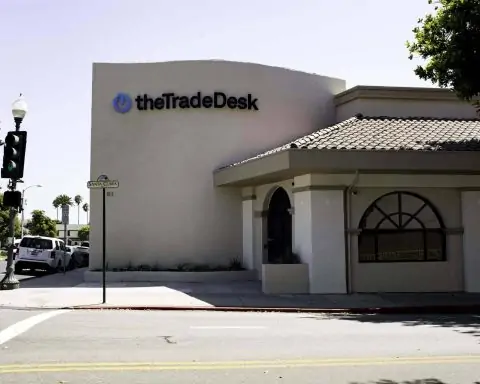After one of the rockiest stretches since spring, the US stock market heads into the weekend bruised but not broken. A powerful rally on Friday, November 21, 2025, pushed the Dow Jones Industrial Average, S&P 500 and Nasdaq Composite solidly higher, even as all three benchmarks still finished the week in the red. [1]
On Saturday, November 22, investors are digesting a confusing mix of signals:
- Mounting expectations of a December Federal Reserve rate cut
- Surging volatility in artificial intelligence (AI) and big‑tech shares
- Evidence of cooling US manufacturing and fragile consumer sentiment
- A historic milestone as Eli Lilly becomes the first healthcare company to hit a $1 trillion valuation [2]
Below is a detailed wrap‑up of what happened on Wall Street on November 21 and what it means as of today, November 22, 2025.
Wall Street Recap: Major US Indexes Rebound but Weekly Losses Remain
Friday’s session saw a broad-based relief rally:
- S&P 500 rose about 1% to roughly 6,603, adding around 64 points. [3]
- Dow Jones Industrial Average jumped about 1.1%, closing near 46,245, up roughly 493 points. [4]
- Nasdaq Composite gained about 0.9% to 22,273. [5]
- Russell 2000, the small‑cap index, outperformed with a surge of roughly 2.8%. [6]
The rebound followed a week of sharp intraday reversals and some of the largest one‑hour moves in months. Even after Friday’s surge, the main US indexes still ended the week lower:
- S&P 500: about ‑1.9% for the week
- Dow: roughly ‑1.9% for the week
- Nasdaq: around ‑2.7% for the week
- Russell 2000: down about 0.8% for the week [7]
In other words, Friday’s rally stopped the bleeding—but didn’t erase it.
Overnight US stock futures also showed strength after the cash close. By early evening Friday, contracts tied to the S&P 500, Dow and Nasdaq were all trading higher, reflecting expectations that Monday could open on firmer footing. [8]
Why Stocks Rallied: Fed Rate‑Cut Bets Flip the Mood
The key catalyst behind Friday’s reversal was a notable shift in expectations for the Federal Reserve’s December meeting.
- New York Fed President John Williams, historically seen as relatively hawkish, signaled that the Fed could still cut interest rates “in the near term” without jeopardizing its inflation goals. [9]
- That comment dramatically changed the market’s view of the December decision:
- The probability of another rate cut rose from roughly 39% to more than 70% in a single day, based on CME FedWatch futures pricing. [10]
Lower expected policy rates support equity valuations by reducing discount rates and easing pressure on rate‑sensitive parts of the market—especially:
- Growth and tech stocks
- Homebuilders and housing‑linked names
- Smaller companies more reliant on bank and bond financing
Bond markets echoed this shift:
- The 10‑year US Treasury yield slipped to just above 4.06%, from about 4.10% the prior day.
- The 2‑year yield, highly sensitive to Fed expectations, fell to around 3.51%, down about 5 basis points. [11]
Lower yields helped fuel a “risk‑on” bounce in stocks after Thursday’s brutal reversal, when the market swung from a huge early gain to a deep loss in its biggest intraday flip since April. [12]
Economic Data: Manufacturing Slows While Inflation Anxiety Lingers
Friday’s macro backdrop was not entirely comforting.
A flash November PMI report from S&P Global showed that US manufacturing activity slowed to a four‑month low, with the index falling to 51.9 from 52.5 in October. [13]
Key details from the report:
- New orders weakened noticeably, signaling softer demand.
- Inventories of finished goods hit their highest level on record in the survey, suggesting products are piling up on shelves and in warehouses.
- Firms continued to cite higher costs tied to tariffs as a major headwind. [14]
At the same time, the University of Michigan consumer survey showed:
- Ongoing frustration with high prices and weak real incomes, especially among lower‑ and middle‑income households.
- A modest improvement in overall sentiment versus earlier in the month, but still low by historical standards. [15]
Inflation expectations remain sticky:
- Businesses reported rising input costs and higher prices charged to customers.
- Consumers’ one‑year inflation expectations picked up, while five‑year expectations eased slightly but stayed above the Fed’s 2% target. [16]
The takeaway: The Fed has room to cut, but not unlimited room. Data isn’t weak enough to force aggressive easing, and inflation is still too high to eliminate the risk that policymakers pause again.
AI and Big Tech: From Market Engine to Source of Volatility
The week’s wild swings centered on AI and mega‑cap tech stocks, which have led the market higher for much of 2025.
Nvidia: Stellar Earnings, Tepid Reaction
Chip giant Nvidia delivered another blockbuster quarterly report with strong guidance, yet its stock fell about 3% on Thursday and another 1% on Friday, leaving it down nearly 6% for the week. [17]
Investors appear to be asking a painful question: How much good news is already in the price?
Oracle and the AI Debt Question
Oracle has become something of a cautionary tale. After a massive debt‑funded push to build AI‑ready data centers, the stock has slid more than 40% from its recent peak and dropped another roughly 5–6% on Friday alone, making it one of the worst performers in the S&P 500 that day. [18]
Concerns focus on:
- Heavy borrowing to fund AI infrastructure
- Whether future AI revenues will justify those investments
- The broader risk that investors have overpaid for the AI story
“Bubble Trouble” in the AI Trade
A detailed Reuters analysis notes that the largest bout of volatility in months has exposed “cracks” in the AI‑driven rally. Key points: [19]
- Many AI‑linked stocks have failed to hold gains even after strong earnings.
- Valuation metrics for parts of the market are stretched, drawing comparisons to the late‑1990s dot‑com boom.
- Retail investor sentiment, however, is far from euphoric, suggesting we may not be in the final blow‑off phase of a bubble—at least not yet.
At the flow level, tech stocks are still pulling in money: Bank of America estimates they are on track for a record $75 billion in net inflows in 2025, even as recent weeks saw rising worries about overvaluation. [20]
In short, AI remains the market’s main growth engine—but also its biggest source of risk.
Big Movers: Retail, Housing and Healthcare Steal the Spotlight
Outside of mega‑cap tech, several sectors quietly delivered standout performances on Friday.
Retailers Ride the Consumer’s Shift to Value
Retail stocks were among the biggest winners:
- Gap surged close to 9–10% after reporting stronger‑than‑expected earnings across its Old Navy, Gap and Banana Republic brands and signaling a more optimistic outlook heading into the holiday season. [21]
- Ross Stores jumped more than 8%, helped by robust off‑price demand as shoppers trade down while still spending. [22]
This performance underscores a key theme: consumers are still spending, but they’re hunting for value.
Homebuilders Pop on Lower‑Yield Hopes
Rate‑sensitive housing stocks also rallied:
- D.R. Horton, Lennar, PulteGroup and Builders FirstSource all logged gains in the 6–7% range as investors priced in the possibility of lower mortgage rates if the Fed delivers another cut in December. [23]
A softer 10‑year yield helps ease financial conditions for homebuyers and construction firms alike, so any hint of more Fed easing tends to lift this group quickly.
Eli Lilly Joins the Trillion‑Dollar Club
The single biggest headline outside of tech came from Eli Lilly:
- The pharmaceutical giant hit a $1 trillion market capitalization on Friday, becoming the first healthcare company ever to reach that milestone. [24]
- Lilly’s surge has been powered by explosive demand for its obesity and diabetes drugs, which investors see as long‑duration, highly profitable franchises. [25]
Analysts quoted by Reuters argue that Lilly now offers an attractive alternative for investors looking to rotate away from volatile AI names while still getting strong earnings growth. [26]
Symbolically, Lilly’s move suggests that leadership in this bull market is broadening, with healthcare finally joining tech at the very top of the valuation ladder.
Flows, Crypto and the Broader Risk Mood
Under the surface, money flows show a market that is nervous—but still engaged.
Equity and Tech Inflows Continue
Reuters fund‑flow data show that: [27]
- US equity funds drew about $4.4 billion in net inflows over the latest week, the fifth straight week of positive flows.
- Large‑cap funds led the way, while mid‑caps saw outflows and small‑caps modest inflows.
- Tech‑focused funds remain on track for record annual inflows, despite the recent AI sell‑off.
This suggests institutions are not abandoning stocks—just rotating within them, particularly toward perceived high‑quality growth stories and large caps.
Bitcoin and Crypto Feel the Heat
If equities look wobbly, crypto looks worse:
- Bitcoin has dropped roughly 27% from its recent peak, falling back toward levels last seen in April.
- Analysts report record outflows from some Bitcoin ETFs, including products run by BlackRock, making November one of the worst months for crypto flows since 2022. [28]
The driver? A combination of:
- Rising US yields earlier in the month
- Fears of an AI‑led stock market correction
- Investors cutting risk across the board
For equities, the crypto slump is more of a sentiment signal than a direct spillover, but it underlines that risk appetite is fragile.
What Today, November 22, 2025, Means for the Week Ahead
With US markets closed for the weekend, today is about positioning rather than price action. Here’s what traders and longer‑term investors will be thinking about:
- December Fed Meeting
- The market is now heavily priced for another rate cut. Any speech or data that challenges that narrative could reignite volatility.
- AI and Big Tech Earnings & Guidance
- Nvidia’s muted reaction to strong results, Oracle’s slide, and Reuters’ “Bubble Trouble” analysis all point to a market that is less willing to blindly chase AI stories. [29]
- Incoming Economic Data
- After the recent government shutdown, investors are starved for fresh official data. Manufacturing PMI and consumer surveys already show a slower but not collapsing economy, with inflation still too high for comfort. [30]
- Sector Rotation
- Strong days for retail, housing and healthcare against a backdrop of tech weakness hint at a broadening market—a positive sign if it lasts.
- Volatility Regime
- The Cboe Volatility Index (VIX) remains elevated in the low‑20s, indicating options traders are still paying up for protection, even after Friday’s rebound. [31]
Bottom Line
For the US stock market as of November 22, 2025, the story is nuanced:
- Good news:
- Strong Friday rally, especially in small caps and cyclicals
- Growing odds of another Fed rate cut in December
- Ongoing inflows into US equities and a historic new $1 trillion healthcare champion
- Bad news:
- Weekly losses across all major indexes
- Rising concerns that AI and big‑tech valuations may be stretched
- Evidence of cooling manufacturing and persistent inflation anxieties
- Crypto markets flashing risk‑off signals
Investors are not fleeing, but they are more selective, more defensive, and far more sensitive to policy and earnings surprises than they were earlier in the year.
As always, this article is for information only and does not constitute investment advice. Market conditions can change quickly, and anyone making financial decisions should consider their own objectives, risk tolerance and independent research.
References
1. apnews.com, 2. www.reuters.com, 3. apnews.com, 4. apnews.com, 5. apnews.com, 6. apnews.com, 7. apnews.com, 8. m.economictimes.com, 9. www.reuters.com, 10. www.reuters.com, 11. www.reuters.com, 12. m.economictimes.com, 13. www.reuters.com, 14. www.reuters.com, 15. www.reuters.com, 16. www.reuters.com, 17. www.investopedia.com, 18. www.investopedia.com, 19. www.reuters.com, 20. www.reuters.com, 21. www.investopedia.com, 22. www.investopedia.com, 23. www.investopedia.com, 24. www.reuters.com, 25. www.alphaspread.com, 26. www.reuters.com, 27. www.reuters.com, 28. coinspot.io, 29. www.reuters.com, 30. www.reuters.com, 31. www.wsj.com









